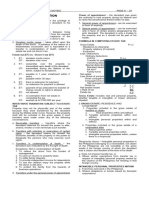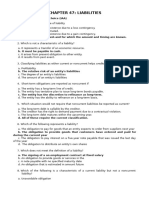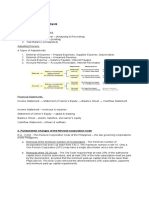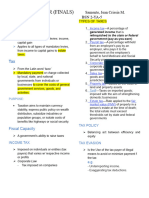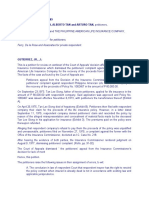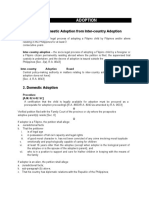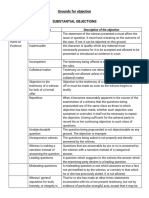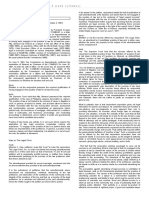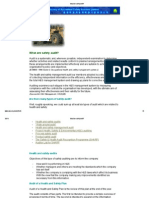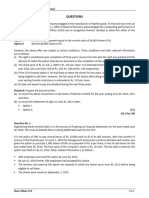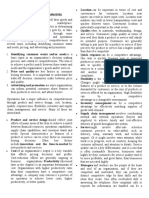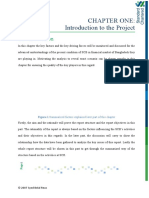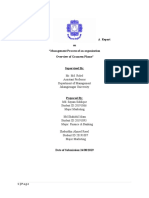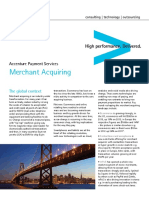Income Taxation Quick Notes
Income Taxation Quick Notes
Uploaded by
KathCopyright:
Available Formats
Income Taxation Quick Notes
Income Taxation Quick Notes
Uploaded by
KathCopyright
Available Formats
Share this document
Did you find this document useful?
Is this content inappropriate?
Copyright:
Available Formats
Income Taxation Quick Notes
Income Taxation Quick Notes
Uploaded by
KathCopyright:
Available Formats
Income Taxation Quick Notes
Function of income tax system
Income taxation – branch of taxation which provides for Madrigal vs. Rafferty Case
statutory and administrative system of imposing and The Income Tax Law of the United States, extended
collecting tax on the yearly profits arising from property, to the Philippine Islands, is the result of an effect on the
professions, trades and offices. part of the legislators to put into statutory form this
canon of taxation and of social reform. The aim has
Nature of income taxation been to mitigate the evils arising from inequalities of
Excise transaction system since it is a taxation on the wealth by a progressive scheme of taxation, which
exercise of a privilege to earn yearly profits from various places the burden on those best able to pay. To carry
sources. out this idea, public considerations have demanded an
exemption roughly equivalent to the minimum of
Basis in imposing income tax subsistence. With these exceptions, the income tax is
1. Partnership theory – theory based on the right supposed to reach the earnings of the entire non-
of a government to tax income emanates from governmental property of the country. Such is the
its partnership in the production of income, by background of the Income Tax Law.
providing the protection, resources, incentive,
and proper climate for such production. (CIR vs. Criteria in imposing Income Tax
Lednicky) 1. Citizenship or Nationality Theory – the country
2. Protection theory - The site of the source of where the income earner is a citizen because he
payments is the Philippines. The flow of wealth is given protection by his country no matter
proceeded from, and occurred within, where he earns his income. He is therefore
Philippine territory, enjoying the protection obliged to give support to his country.
accorded by the Philippine government. In
consideration of such protection, the flow of 2. Residence or Domiciliary Theory – the country
wealth should share the burden of supporting where the income earner resides for the reason
the government. that he is given protection in his place of
3. Favorable Business Climate Theory - Domestic residence.
corporations owe their corporate existence and
their privilege to do business to the
3. Source – the country where the source of
government. They also benefit from the efforts
income is where the activity that produced the
of the government to improve the financial
income took place. Not where the money
market and to ensure a favorable business
originated. So you should look into where the
climate. It is therefore fair for the government
activity took place that produced the income.
to require them to make a reasonable
contribution to the public expenses.
Features of Philippine Income Tax
Doctrine of Moral Neutrality of the Taxing Authority
- These theories are the reason behind the law
The Establishment Clause principally prohibits the State
requirement payment of income taxes.
from sponsoring any religion, or favoring any religion as
against other religions. It mandates a strict neutrality in
Income tax systems:
affairs among religious groups. No tax in any amount,
1. As to manner of imposition:
large or small, can be levied to support any religious
a. Global tax system
activities or institutions, whatever they may be called,
b. Schedular tax system
or whatever form they may adopt to teach or practice
c. Semi global/schedular
religion.
2. As to applicable tax law
a. NIRC
This doctrine believes that the "wall of separation" does
b. Special laws
not require the state to be their adversary. Rather, the
3. As to tax rate
state must be neutral in its relations with groups of
a. Progressive
religious believers and nonbelievers." State power is no
b. Regressive
more to be used so as to handicap religious than it is to
c. Proportionate
favor them. The Strict Neutrality approach is not hostile
to religion, but it is strict in holding that religion may not Dividends – payment made by the company to
be used as a basis for classification for purposes of shareholders or owners of stocks, way to distribute back
governmental action, whether the action confers right to investors the revenue, ways that an investor earns.
or privileges or imposes duties or obligations. Only Also termed as cash dividend which is taxable.
secular criteria may be the basis of government action.
It does not permit, much less require, accommodation Stock Dividends – is the dividend payment made in the
of secular programs to religious belief. form of additional shares rather than a cash payout. The
company may decide to give this to the shareholders
Types of Philippine Income Tax instead of liquid cash, they are not taxable until they are
1. Gross income tax – occurs when the tax base is sold.
the total gross income of an individual or
corporation during the taxable year without
deductions whatsoever. Sources of income:
2. Net income tax – occurs when the tax base is 1. Services rendered or labor
the total gross income of an individual that has 2. Capital which is not limited to money or
claimed and was granted a deduction. property
3. Presumptive income tax – allowed in the 3. Gains from exchange of properties or gains
context of capital gains tax. It is a concept of from profit.
taxation according to which income tax is based
on "average" income instead of actual income. Related concepts
4. Composite tax – tax consisting of quasi-personal a. Return of Capital Return of capital (ROC) is a
taxes, assessed on the particular source of payment, or return, received from an
income with a superimposed personal tax on investment that is not considered a taxable
the income as a whole. event and is not taxed as income. Capital is
5. Unitary tax returned, for example, on retirement accounts
and permanent life insurance policies; regular
investment accounts return gains first. is the
INCOME – means all wealth which flows into the return of the principal only, and it is not any
taxpayer other than as a mere return of capital. It gain or any loss as a result of the investment
includes the form of income specifically described as NOT TAXABLE, reason: Because it is money
gains derives from sale or other disposition of capital being returned and not earned, it’s not
considered taxable income. Once returns exceed
It is the amount of money coming to a person or the original initial investment, it counts as a
corporation within a specified time, whether as capital gain and is therefore taxable.
payment for services, interest, or profits from
investment. b. Return on capital (ROC) is a ratio that
measures how well a company turns capital
Other terms: (e.g. debt, equity) into profits. In other words,
Capital – is the funds or property existing at one distinct ROC is an indication of whether a company is
point of time. It is the wealth. using its investments effectively to maintain and
protect their long-term profits and market share
Receipts – has reference to all wealth that flows into the against competitors. Return on capital is also
taxpayer which includes return of capital. It is broader in known as return on invested capital (ROIC). It is
scope than income. It does not necessarily mean an accounting measure. Return of capital refers
income, this is what is received and includes the income to a company returning original investment
in its definition (literally yots, receipt “kung unsay funds back to the investor or by liquidating
nadawat”) assets. Return on capital refers to a company’s
profitability.
Revenue – as applied to taxation, refers to all the funds
of income derived by the government, whether from
c. Revenue Revenue is the income generated
tax or any other source.
from normal business operations and includes
discounts and deductions for returned
merchandise. It is the top line or gross income absolutely, only that a taxpayer has at his
figure from which costs are subtracted to disposal the information necessary to compute
determine net income. the amount with reasonable accuracy. The all-
As applied to taxation, it refers to all funds or events test is satisfied where computation
income derived by the government, whether remains uncertain, if its basis is unchangeable;
from tax or any other source. Revenue is to the the test is satisfied where a computation may
government, income is to person or be unknown, but is not as much as unknowable,
corporation. within the taxable year. The amount of liability
does not have to be determined exactly; it must
d. Receipts Has reference to all wealth that be determined with "reasonable accuracy.
flows into the taxpayer which includes return of "Accordingly, the term "reasonable accuracy"
capital. It refers to amounts one has earned as implies something less than anex act or
the result of business activities such as selling completely accurate amount.
merchandise or performing services. Broader in
scope than income.
The accrual of income and expense is permitted
e. Accounting income Accounting income is the when the all-events test has been met. This test
profit a company retains after paying off all requires: (1) fixing of a right to income or liability to pay;
relevant expenses from sales revenue earned. It and (2) the availability of the reasonable accurate
is synonymous with net income, which is most determination of such income or liability.
often found at the end of the income
statement. The metric differs from gross income 4. Economic Benefit Principle – Any economic
in that the latter accounts for only direct benefit to the employee that increases his net
expenses, whereas accounting income also worth, whatever may have been the mode by
takes into consideration all indirect expenses. which it is effect, is taxable.
Test of Taxable income 5. Severance test – There is no taxable income
1. Flow of Wealth test This test is based on the until there is a separation from capital of
definition of gross income under sec. 29, sec. 3 something of exchangeable value, thereby
particularly the term and income derived from supplying the realization or transmutation
any source whatever. which would result in the receipt of income.
The site of the source of payments is the Philippines. 6. Substantial alteration test – There is no
The flow of wealth proceeded from, and occurred taxable income until there is a separation from
within, Philippine territory, enjoying the protection capital of something of exchangeable value,
accorded by the Philippine government. In thereby supplying the realization or
consideration of such protection, the flow of wealth transmutation which would result in the receipt
should share the burden of supporting the government. of income.
2. Realization Test Under the realization 7. Control test Power to dispose; Assignment of
principle, revenue is generally recognized when income doctrine
both of the following conditions are met: (1) the
earning process is complete or virtually
complete; and, (2) an exchange has taken place.
This principle requires that revenue must be
earned before it is recorded.
3. All – event test The all-events test requires
the right to income or liability be fixed, and the
amount of such income or liability be
determined with reasonable accuracy.1âwphi1
However, the test does not demand that the
amount of income or liability be known
You might also like
- Wyndham Worldwide 1Document26 pagesWyndham Worldwide 1Jackie Gamez Garcia67% (3)
- Comprehensive Problem 1 The Accounting Cycle PDFDocument2 pagesComprehensive Problem 1 The Accounting Cycle PDFercis64210% (3)
- Self-Test Problems (Solutions in Appendix B) : LG5 LG2Document6 pagesSelf-Test Problems (Solutions in Appendix B) : LG5 LG2Hamad Gul0% (1)
- Coursera CARQCAHD3BYADocument1 pageCoursera CARQCAHD3BYASantu BiswaaNo ratings yet
- Asset Inventory: XYZ Company $ 250.00Document4 pagesAsset Inventory: XYZ Company $ 250.00Yvette NeethlingNo ratings yet
- Chapter 12 Transfer TaxationDocument14 pagesChapter 12 Transfer TaxationCamila MolinaNo ratings yet
- Dealings in PropertyDocument30 pagesDealings in PropertyPrie DitucalanNo ratings yet
- Special Rules On Capital Transactions (Capital Gains and Losses)Document40 pagesSpecial Rules On Capital Transactions (Capital Gains and Losses)AngeliqueGiselleCNo ratings yet
- Shareholders EquityDocument25 pagesShareholders EquityJhoanna Mary PescasioNo ratings yet
- RFBT 10 SalesDocument12 pagesRFBT 10 SalesKrizzia DizonNo ratings yet
- Topic 3 - Magna Carta For Disabled PersonsDocument38 pagesTopic 3 - Magna Carta For Disabled PersonsNddejNo ratings yet
- The Intermediate Accounting Series Volume 2 2016 Empleo Robles SolmanDocument239 pagesThe Intermediate Accounting Series Volume 2 2016 Empleo Robles SolmanAngelika AureNo ratings yet
- Strategic Tax Management - Week 3Document14 pagesStrategic Tax Management - Week 3Arman DalisayNo ratings yet
- Sme VS PFRSDocument17 pagesSme VS PFRSDesai SarvidaNo ratings yet
- Income Taxation Midterm ReviewerDocument16 pagesIncome Taxation Midterm ReviewerRAMIREZ, MARVIN L.No ratings yet
- Chapter 4 - Risk Assessment ProceduresDocument40 pagesChapter 4 - Risk Assessment ProceduresTeltel BillenaNo ratings yet
- 23 Review Material 23 RFBTDocument21 pages23 Review Material 23 RFBT버니 모지코No ratings yet
- Chapter 1 General Provisions: Creation Juridical PersonalityDocument22 pagesChapter 1 General Provisions: Creation Juridical PersonalityMark CalimlimNo ratings yet
- FM Unit 7 Lecture Notes - Cost of CapitalDocument2 pagesFM Unit 7 Lecture Notes - Cost of CapitalDebbie DebzNo ratings yet
- SM Investments Corporation Budgeted Income Statement For Years 2021-2025Document1 pageSM Investments Corporation Budgeted Income Statement For Years 2021-2025Jezeil DimasNo ratings yet
- 1st Semester Transfer Taxation Module 1 Succession and Transfer TaxDocument5 pages1st Semester Transfer Taxation Module 1 Succession and Transfer TaxNah HamzaNo ratings yet
- College For Research & Technology of Cabanatuan: VisionDocument8 pagesCollege For Research & Technology of Cabanatuan: VisionAnn De GuzmanNo ratings yet
- Tax2 Property RelationshipDocument28 pagesTax2 Property RelationshipMaine JavierNo ratings yet
- Professiona Review & Training Center, IncDocument14 pagesProfessiona Review & Training Center, IncBryan Christian MaragragNo ratings yet
- The Negotiable Instruments Law I. Form and Interpretation: Page 1 of 11Document11 pagesThe Negotiable Instruments Law I. Form and Interpretation: Page 1 of 11Claudine ArrabisNo ratings yet
- RFBT - Credit TransactionsDocument2 pagesRFBT - Credit TransactionsglcpaNo ratings yet
- 93-01 General Principles QuestionnaireDocument12 pages93-01 General Principles QuestionnaireJuan Miguel UngsodNo ratings yet
- Quizlet PDFDocument12 pagesQuizlet PDFHatake KakashiNo ratings yet
- Estate & Donors TaxationDocument7 pagesEstate & Donors TaxationDaphnie BoloNo ratings yet
- Conso FS at The Date of AcquisitionDocument3 pagesConso FS at The Date of Acquisitionguliramsam5No ratings yet
- Income Taxation Chapter 1 3Document65 pagesIncome Taxation Chapter 1 3Abegail Joy CabalfinNo ratings yet
- CH07 Gross EstateDocument9 pagesCH07 Gross EstateRenelyn FiloteoNo ratings yet
- 04AFAR QuicknotesDocument23 pages04AFAR Quicknoteshelican.wenajeandbsa1993100% (1)
- Intermediate Accounting 2 THEORIESDocument68 pagesIntermediate Accounting 2 THEORIESLedelyn MaullonNo ratings yet
- PPE Part 1Document5 pagesPPE Part 1Aleck CondesNo ratings yet
- Items of Gross Income Subject To RegularDocument2 pagesItems of Gross Income Subject To Regularace zeroNo ratings yet
- Business TaxesDocument51 pagesBusiness TaxesLuna CakesNo ratings yet
- Income Tax Inclusion From Gross IncomeDocument5 pagesIncome Tax Inclusion From Gross IncomeSharmaine Clemencio0No ratings yet
- Lecture 2c - Dealings in PropertyDocument4 pagesLecture 2c - Dealings in PropertyCPANo ratings yet
- Lecture 3 - Income Taxation (Corporate)Document5 pagesLecture 3 - Income Taxation (Corporate)Paula MerrilesNo ratings yet
- BP 22 VS ESTAFA Copy 1Document8 pagesBP 22 VS ESTAFA Copy 1suchezia lopezNo ratings yet
- Law On Sales SummaryDocument11 pagesLaw On Sales SummaryMusic LastNo ratings yet
- Accounting ReviewerDocument9 pagesAccounting Reviewerkeisha santosNo ratings yet
- Income Taxation Compressed SummaryDocument190 pagesIncome Taxation Compressed SummaryYvette RufoNo ratings yet
- Gross Income Deductions - Lecture Handout PDFDocument4 pagesGross Income Deductions - Lecture Handout PDFKarl RendonNo ratings yet
- Notes On Classification of Costs and Cost ConceptsDocument5 pagesNotes On Classification of Costs and Cost ConceptsAngela Mae Balanon RafananNo ratings yet
- 7084 Multiple Choice Small Entities Lecture Notes and SolutionDocument4 pages7084 Multiple Choice Small Entities Lecture Notes and SolutionpompomNo ratings yet
- Dealings in PropertiesDocument2 pagesDealings in PropertiesJamaica DavidNo ratings yet
- Mas 05 - Differential CostingDocument5 pagesMas 05 - Differential CostingCarl Angelo LopezNo ratings yet
- Sales: Title VL Sales Nature and Form of The ContractDocument92 pagesSales: Title VL Sales Nature and Form of The ContractMa Tiffany CabigonNo ratings yet
- Omnibus Investment CodeDocument7 pagesOmnibus Investment CodeKimmee LeeNo ratings yet
- Value Added TaxDocument8 pagesValue Added TaxErica VillaruelNo ratings yet
- Gross Compensation Income Summary IIDocument7 pagesGross Compensation Income Summary IITriciaNo ratings yet
- Chap09 Guerrero Consolidated FsDocument50 pagesChap09 Guerrero Consolidated FsMARTINEZ Wyssa ElaineNo ratings yet
- CTT Examination Reviewer (Notes) Page A - 30Document13 pagesCTT Examination Reviewer (Notes) Page A - 30Seneca GonzalesNo ratings yet
- Acc 61 1stsem Sy2021 Gutierrez, FerdinandDocument6 pagesAcc 61 1stsem Sy2021 Gutierrez, FerdinandrnNo ratings yet
- Law On Sales Agency and Credit TransactionsDocument2 pagesLaw On Sales Agency and Credit TransactionsYanaNo ratings yet
- Rfli Midterm ReviewerDocument20 pagesRfli Midterm ReviewerKatrina PaquizNo ratings yet
- Financial Management Notes SummaryDocument6 pagesFinancial Management Notes SummaryAeris StrongNo ratings yet
- Law NotesDocument14 pagesLaw NotesZaimaery LambitNo ratings yet
- Tax BT Introduction To VATDocument5 pagesTax BT Introduction To VATJoshua Phillip TorcedoNo ratings yet
- Ethics Reviewer (Finals)Document4 pagesEthics Reviewer (Finals)Jean SamonteNo ratings yet
- Income Tax NotesDocument16 pagesIncome Tax NotesmindanaokristinekhayeNo ratings yet
- Chapter 1 Income TaxationDocument11 pagesChapter 1 Income Taxationviceduard teclingNo ratings yet
- Air Manila vs. BalatbatDocument2 pagesAir Manila vs. BalatbatKathNo ratings yet
- Fabella vs. CADocument7 pagesFabella vs. CAKathNo ratings yet
- Merchandising Corporation vs. Leo Enterprises, Inc. by Virtue of Such, The Sheriff Levied and Attached A Second HandDocument4 pagesMerchandising Corporation vs. Leo Enterprises, Inc. by Virtue of Such, The Sheriff Levied and Attached A Second HandKathNo ratings yet
- Dorado vs. PeopleDocument10 pagesDorado vs. PeopleKathNo ratings yet
- G.R. No. 83736 January 15, 1992 Commissioner of Internal Revenue, PetitionerDocument5 pagesG.R. No. 83736 January 15, 1992 Commissioner of Internal Revenue, PetitionerKathNo ratings yet
- O.F. Santos & P.C. Nolasco For Petitioners. Ferry, de La Rosa and Associates For Private RespondentDocument5 pagesO.F. Santos & P.C. Nolasco For Petitioners. Ferry, de La Rosa and Associates For Private RespondentKathNo ratings yet
- G.R. No. 186533 August 9, 2010 PEOPLE OF THE PHILIPPINES, Plaintiff-AppelleeDocument9 pagesG.R. No. 186533 August 9, 2010 PEOPLE OF THE PHILIPPINES, Plaintiff-AppelleeKathNo ratings yet
- Corporation Law - Second Set Case DigestDocument108 pagesCorporation Law - Second Set Case DigestKathNo ratings yet
- Problem Areas in Legal Ethics First Exam Atty. Ivy B. LuricaDocument7 pagesProblem Areas in Legal Ethics First Exam Atty. Ivy B. LuricaKathNo ratings yet
- Distinguish Domestic Adoption From Inter-Country AdoptionDocument6 pagesDistinguish Domestic Adoption From Inter-Country AdoptionKathNo ratings yet
- Grounds For ObjectionsDocument4 pagesGrounds For ObjectionsKath100% (2)
- Piercing The Veil of Corporate EntityDocument1 pagePiercing The Veil of Corporate EntityKathNo ratings yet
- Rule 99-100 (Domestic Adoption)Document15 pagesRule 99-100 (Domestic Adoption)KathNo ratings yet
- (1-3 Week Syllabus) : 1 - Case Digests Under P.A.L.EDocument2 pages(1-3 Week Syllabus) : 1 - Case Digests Under P.A.L.EKathNo ratings yet
- (Tulor vs. Hon. Garcia G.R. No. L-46934 April 15, 1988) : Exam 1 Answers: Multiple Choice and Essay (15 & 4-7)Document1 page(Tulor vs. Hon. Garcia G.R. No. L-46934 April 15, 1988) : Exam 1 Answers: Multiple Choice and Essay (15 & 4-7)KathNo ratings yet
- SPOM Book IndexDocument13 pagesSPOM Book IndexsangammanavarprajwalNo ratings yet
- Are There Many Types of Safety Audit?Document6 pagesAre There Many Types of Safety Audit?Khatri NasrullahNo ratings yet
- FinMan 1 - Prelim Reviewer 2017Document17 pagesFinMan 1 - Prelim Reviewer 2017Rachel Dela Cruz100% (1)
- Proiect Practica Master PublicitateDocument6 pagesProiect Practica Master PublicitateMaria Ioana IlieNo ratings yet
- Measuring Safety Performance SlidesDocument66 pagesMeasuring Safety Performance SlidesRobinson Gultom100% (2)
- Ergode v1Document12 pagesErgode v1sahilsushilboharaNo ratings yet
- EY 6 Trends That Will Change The TV Industry PDFDocument24 pagesEY 6 Trends That Will Change The TV Industry PDFFaizahKadirNo ratings yet
- Inventory System For Marisol Grocery Store - MODIFIEDDocument36 pagesInventory System For Marisol Grocery Store - MODIFIEDKevin Tuazon33% (3)
- ICAP Past Exams (Questions) - IFRS 2Document5 pagesICAP Past Exams (Questions) - IFRS 2kashan.ahmed1985No ratings yet
- 6 Training PlanDocument9 pages6 Training PlanDinesh Kanukollu100% (1)
- Search Strings RulesDocument3 pagesSearch Strings RulesDeepthiNo ratings yet
- Adatis PowerBI PDFDocument3 pagesAdatis PowerBI PDFsteve257No ratings yet
- Washpool Hard Coking Coal Project Feasibility Study CompletedDocument6 pagesWashpool Hard Coking Coal Project Feasibility Study CompletedTessfaye Wolde GebretsadikNo ratings yet
- Shaheed Sukhdev College of Business StudiesDocument7 pagesShaheed Sukhdev College of Business StudiesrandhawakaranNo ratings yet
- Week 1 Module 2Document4 pagesWeek 1 Module 2Nikka VelascoNo ratings yet
- Partnership Liquidation Q10docx 4 PDF FreeDocument1 pagePartnership Liquidation Q10docx 4 PDF FreecamillaNo ratings yet
- Strategic HRM Plan For Standard Chartered Bank Limited (Bangladesh)Document120 pagesStrategic HRM Plan For Standard Chartered Bank Limited (Bangladesh)Belal Reza100% (1)
- Business PlanDocument16 pagesBusiness PlanHamid Asghar100% (1)
- Financial Statement Analysis Project - Fall 2012-1Document9 pagesFinancial Statement Analysis Project - Fall 2012-1rajesh934No ratings yet
- Externalities Causing Market FailureDocument15 pagesExternalities Causing Market Failureapi-53255207No ratings yet
- SAP FI Tables ListDocument19 pagesSAP FI Tables ListAjinkya MohadkarNo ratings yet
- Project Name Business Requirements Document (BRD) TemplateDocument24 pagesProject Name Business Requirements Document (BRD) Templatekcpmeo22No ratings yet
- Homework On Inventories Problem 1 (Borrowing Cost ConceptsDocument3 pagesHomework On Inventories Problem 1 (Borrowing Cost ConceptsJazehl Joy ValdezNo ratings yet
- Management Process of Grameen PhoneDocument30 pagesManagement Process of Grameen Phonesayamsiddique 42278899126No ratings yet
- Accenture Payment Services Merchant AcquiringDocument4 pagesAccenture Payment Services Merchant AcquiringNature GraceNo ratings yet
- Module 4 - Keeping The Team On TrackDocument116 pagesModule 4 - Keeping The Team On TrackTAPASsenguptaNo ratings yet




























